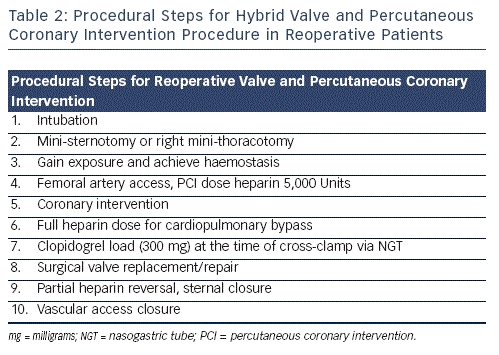Procedural Details
Two-stage Procedures
The concept of the hybrid operation emerged in the mid-1990s as a strategy for coronary revascularisation in the setting of acute myocardial infarction (AMI).13 In the most common scenario, a patient who presented with an AMI was emergently taken for angioplasty and found to have multivessel disease. The culprit lesion was treated percutaneously and the remaining coronary disease was treated with a subsequent CABG. Thereafter, staged PCI and CABG, frequently with off-pump or minimally invasive CABG, was developed as a treatment option for elective coronary revascularisation.14-17
Expanding on this concept, it was realised that patients with valvular disease who presented with an AMI  could be managed similarly. First described in 2005 by Byrne et al., the hybrid approach was defined as a staged procedure with initial PCI in the cardiac catheterisation laboratory followed by open valve surgery during the same admission.18 With further experience it became apparent this hybrid approach could be extended to elective procedures. Brinster et al. reported the use of a hybrid approach in 18 high-risk, elderly patients with aortic stenosis who were found to have CAD amenable to PCI during the pre-operative coronary angiogram.19 PCI was performed with DES either the night before or morning of the aortic valve replacement (AVR). This strategy produced excellent outcomes and paved the way for single-stage procedures.
could be managed similarly. First described in 2005 by Byrne et al., the hybrid approach was defined as a staged procedure with initial PCI in the cardiac catheterisation laboratory followed by open valve surgery during the same admission.18 With further experience it became apparent this hybrid approach could be extended to elective procedures. Brinster et al. reported the use of a hybrid approach in 18 high-risk, elderly patients with aortic stenosis who were found to have CAD amenable to PCI during the pre-operative coronary angiogram.19 PCI was performed with DES either the night before or morning of the aortic valve replacement (AVR). This strategy produced excellent outcomes and paved the way for single-stage procedures.
Single-stage Procedures
With the advent of the hybrid operating room, the PCI and CABG could be performed concurrently in a 'one-stop' hybrid approach,10which was quickly extrapolated to hybrid valve/PCI procedures.5,20 For complex, mixed coronary and valvular disease, especially in the reoperative setting, this strategy has proven especially useful. Not only does the patient potentially benefit from the improved convenience and safety of a single procedure, but resource utilisation may be improved due to use of a single clinical team and procedure room, and possibly decreased duration of hospitalisation.21
A single-stage strategy, utilising the hybrid operating suite, has become the standard approach at our institution. Pre-procedure planning goes beyond that typical for a surgical valve/CABG - the anticoagulation strategy and bleeding risks must be taken into consideration, the appropriate surgical and interventional equipment must be available, and the hybrid room must be staffed with individuals knowledgeable in both open cardiac surgery and interventional cardiology.
Description of the Single-stage Valve and Percutaneous Coronary Intervention Procedure in a Non-reoperative Patient
In our practice, the patient is loaded with clopidogrel 300 milligrams (mg) at the time of transfer to the operating room. Once inside the hybrid suite, the patient is positioned supine and standard anaesthesia protocols are followed regarding monitoring, lines and intubation. For a minimally invasive aortic valve replacement, a small, approximately 4-6 centimetres (cm), skin incision is made, centred over the angle of Louis at the second intercostal space, and the hemisternotomy is completed with a 'J' to the right fourth intercostal space. Haemostasis is achieved and the thymus divided, and aorta exposed by creating a standard pericardial well. For a minimally invasive mitral repair or replacement, a right mini-thoracotomy is utilised  for direct access to the mitral valve.Once surgical exposure is complete, attention is turned to the PCI. Femoral artery access is gained with the modified Seldinger technique and a 6 or 7 French size (Fr) sheath is placed for the intervention. The patient is given a PCI dose of heparin, usually 5,000 units, and the PCI is completed in the standard fashion.
for direct access to the mitral valve.Once surgical exposure is complete, attention is turned to the PCI. Femoral artery access is gained with the modified Seldinger technique and a 6 or 7 French size (Fr) sheath is placed for the intervention. The patient is given a PCI dose of heparin, usually 5,000 units, and the PCI is completed in the standard fashion.
The full cardiopulmonary bypass dose of heparin is then administered, the patient is cannulated, and the valve operation completed. Pacing wires and chest tubes are placed with the heart decompressed. After the conclusion of cardiopulmonary bypass, a partial heparin reversal (typically half the protamine dose) is administered, the patient is decannulated, haemostasis is achieved and the chest is closed. As a final step, the femoral artery access site is closed with a percutaneous closure device or manual compression per institution protocol (see Table 1).
Single-stage Valve and Percutaneous Coronary Intervention in Reoperative Patients
For a reoperative patient, the steps are altered slightly to take into account the extensive dissection often needed due to adhesions. The ternotomy or mini-thoracotomy, all necessary mediastinal dissection, and vascular access are completed prior to the administration of any anticoagulation. Subsequently, a PCI dose of heparin is administered and the intervention completed.
Attention is then turned to the valve operation, full anticoagulation is administered and cardiopulmonary bypass cannulas are placed.
Clopidogrel 300 mg is given via a nasogastric tube at the time of placement of the cross-clamp. The operation is completed in the typical fashion for the respective valve repair/replacement. Partial heparin reversal is administered at the time of decannulation, with full reversal if excessive bleeding is present. The chest is then closed and femoral artery haemostasis is achieved. (See Table 2).